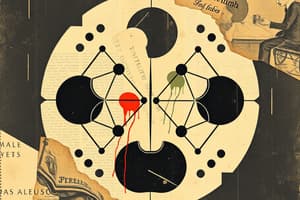Podcast
Questions and Answers
What is one primary purpose of cell division in organisms?
What is one primary purpose of cell division in organisms?
- To produce offspring and repair damaged cells (correct)
- To accumulate waste materials for elimination
- To enhance energy production within cells
- To increase the size of existing cells
Which phase of the cell cycle involves DNA duplication?
Which phase of the cell cycle involves DNA duplication?
- G0 phase
- Cell division
- S phase (correct)
- G1 phase
What happens to immune cells like lymphocytes during the G0 phase?
What happens to immune cells like lymphocytes during the G0 phase?
- They undergo meiosis to produce gametes
- They stop all cellular functions
- They divide continuously to replace dead cells
- They remain inactive until needed for immune response (correct)
What characterizes cancerous cells during the cell cycle?
What characterizes cancerous cells during the cell cycle?
What role do cell cycle checkpoints play in cell division?
What role do cell cycle checkpoints play in cell division?
Which type of cell division occurs for somatic cells?
Which type of cell division occurs for somatic cells?
Which type of tumor is considered harmless and can often be cured through removal?
Which type of tumor is considered harmless and can often be cured through removal?
Which of the following is NOT a risk factor contributing to cancer?
Which of the following is NOT a risk factor contributing to cancer?
Why do cancer cells pose a danger to the body?
Why do cancer cells pose a danger to the body?
What primarily causes cancerous cells to develop?
What primarily causes cancerous cells to develop?
Flashcards are hidden until you start studying
Study Notes
Introduction
- Organisms reproduce to ensure species survival through cell division.
- Cell division enables the production of offspring and the replacement of damaged cells.
- Two types of cell division: mitosis (somatic cells) and meiosis (gametes).
Overview of the Cell Cycle
- The cell cycle consists of distinct phases of growth, DNA replication, and division.
- Divided into two main stages:
- Interphase: non-dividing (G1, S, G2 phases, G0)
- Cell Division: mitosis for somatic cells and meiosis for gametes.
Stage 1: Interphase
- Interphase is the growth phase where cells replicate genetic material and organelles.
- Some cells enter the G0 phase, where they are unlikely to divide but continue normal functions.
Stage 2: Cellular Division
- Highly differentiated cells like neurons and heart muscle cells are often permanently in G0.
- Lymphocytes can remain in G0 for years until needed for immune response.
Cell Cycle Checkpoints
- Checkpoints regulate cell cycle progression to prevent mutations and ensure correct timing.
- Cells assess internal conditions at checkpoints to decide on phase progression.
Cancer
- Cancer is characterized by uncontrolled abnormal cell division and can result from cell cycle disruptions.
- Tumors can be benign (non-invasive) or malignant (can metastasize).
- Causes of cancer include:
- Lifestyle factors (e.g., smoking, high-fat diet).
- Genetic factors (family history).
- Environmental exposures (viruses, carcinogens).
Effects of Tumors
- Cancer cells do not perform normal functions, affecting overall body health.
- Tumors can crowd organs, competing for nutrients and blood supply.
Cancer Treatment
- Chemotherapy: uses drugs to kill actively dividing cells, administered systemically.
- Surgery: involves the removal of cancerous tissue.
- Radiation therapy: uses X-rays to kill cancer cells and shrink tumors.
Genetic Disorders
- Chromosome abnormalities can cause serious health issues due to errors in cell division.
- Karyotyping: a technique to analyze chromosomes for abnormalities.
Numerical Abnormalities
- Aneuploidy: abnormal number of chromosomes.
- Down Syndrome (Trisomy 21): third copy of chromosome 21; physical traits include short neck and slanted eyes.
- Turner Syndrome (45, XO): missing or abnormal X chromosome; affects females and may include short stature and webbed neck.
- Klinefelter Syndrome (47, XXY): extra X chromosome in males; leads to infertility and physical differences.
- Trisomy X Syndrome (47, XXX): extra X chromosome in females; mild symptoms, often taller than average.
- Patau Syndrome (Trisomy 13): extra chromosome 13; physical traits include cleft lip and polydactyly.
- Edward Syndrome (Trisomy 18): extra chromosome 18; characterized by developmental delays and various physical defects.
Structural Abnormalities
- Altered chromosome structures lead to genetic conditions.
- Deletion: missing segment of a chromosome.
- Duplication: repeated segment of a chromosome.
- Translocation: transfer of a chromosome segment to a non-homologous chromosome.
- Inversion: rotation of a chromosome segment by 180 degrees.
Cri-du-chat Syndrome
- Caused by deletion on the short arm of chromosome 5; associated with mental retardation and characteristic cry.
Studying That Suits You
Use AI to generate personalized quizzes and flashcards to suit your learning preferences.





